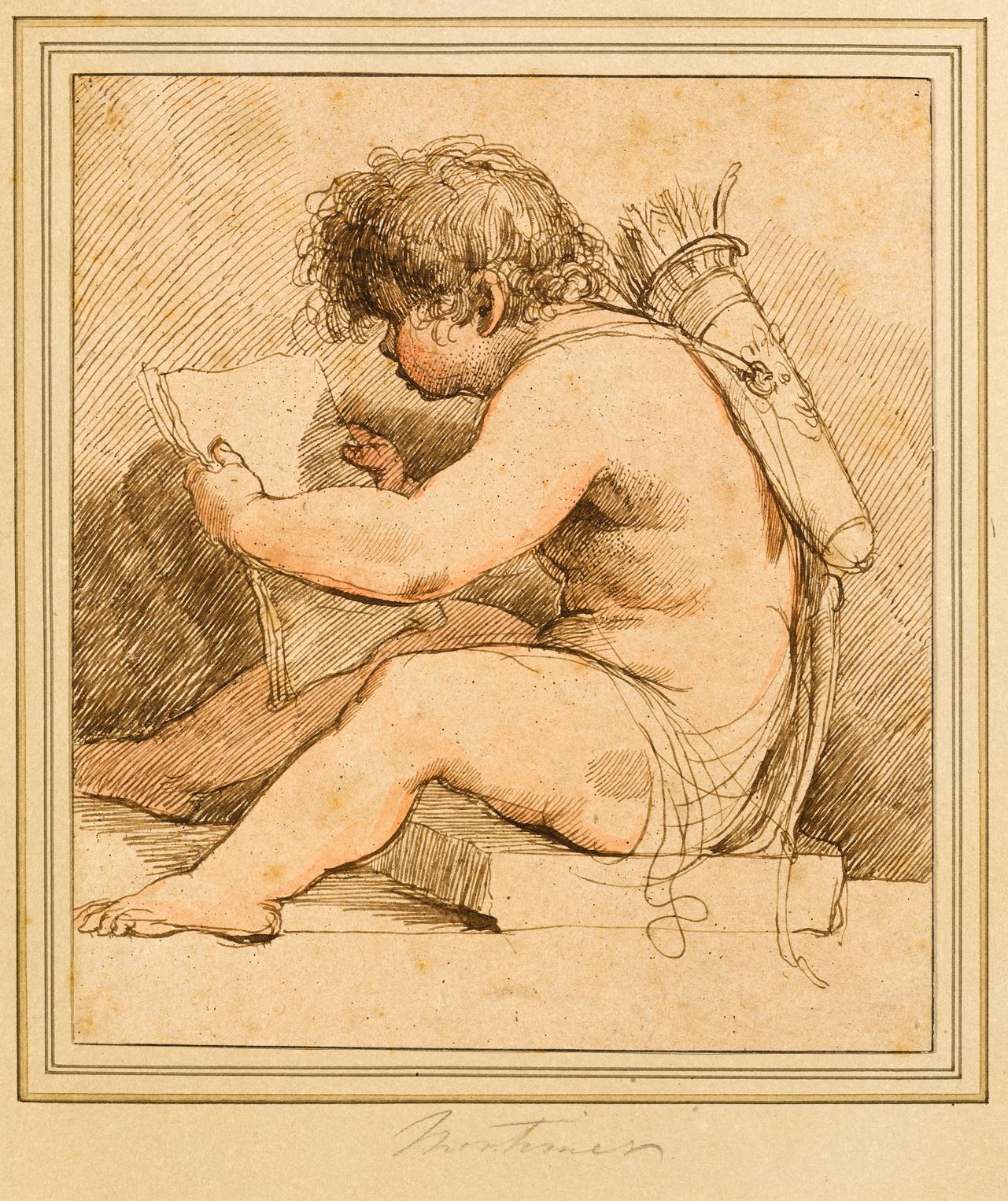John Hamilton MORTIMER
(Eastbourne 1740 - London 1779)
Cupid
Sold
Pen and black ink and a reddish wash.
Laid down on a late 18th or 19th century mount.
Inscribed Mortimer and John Hamilton Mortimer [partially cut off] on the mount.
163 x 148 mm. (6 3/8 x 5 3/4 in.)
Laid down on a late 18th or 19th century mount.
Inscribed Mortimer and John Hamilton Mortimer [partially cut off] on the mount.
163 x 148 mm. (6 3/8 x 5 3/4 in.)
Mortimer was recognized by his contemporaries as a highly inventive and original artistic talent. His work was strongly influenced by the example of such Italian artists as the Carracci, Guercino, Giambattista Piazzetta and, in particular, Salvator Rosa. (Indeed, he was sometimes known as ‘the English Salvator’.) He was especialy admired as a draughtsman, and several of his numerous drawings - after Shakesperean subjects or other literary themes, as well as more fantastical themes - were reproduced as engravings and etchings. His close friend, the architect James Gandon, recalled of Mortimer that ‘the rapidity of his execution was astonishing, and his powers of drawing superior to anything produced by his contemporaries.’
Such appreciation of Mortimer’s talent as a draughtsman has continued to the present day. As one modern scholar has noted, ‘From all accounts Mortimer possessed prodigious facility. Those sheets we now prize so highly were thrown off in a few minutes, and soon littered the studio. Hundreds have been lost, and this is why, among those that happen to survive, it is so seldom possible to connect one with another.’ More recently, John Sunderland has written that ‘Mortimer’s pen-and-ink drawing style, with its use of hatching and dotting, is so peculiar to his work that it can be seen as one of his most significant contributions to the art of the 1770s.’
Such appreciation of Mortimer’s talent as a draughtsman has continued to the present day. As one modern scholar has noted, ‘From all accounts Mortimer possessed prodigious facility. Those sheets we now prize so highly were thrown off in a few minutes, and soon littered the studio. Hundreds have been lost, and this is why, among those that happen to survive, it is so seldom possible to connect one with another.’ More recently, John Sunderland has written that ‘Mortimer’s pen-and-ink drawing style, with its use of hatching and dotting, is so peculiar to his work that it can be seen as one of his most significant contributions to the art of the 1770s.’
Among the most eccentric and imaginative artists of the 18th century in England, John Hamilton Mortimer left his native Eastbourne around 1757 to study in London, first with Thomas Hudson (where among his fellow students was Joseph Wright of Derby) and later with Robert Edge Pine, Joseph Wilton and Giovanni Battista Cipriani. Mortimer won prizes for drawing at the St. Martin’s Lane Academy between 1759 and 1762, and also attended Shipley’s art school on the Strand. He began his independent career as a history painter, exhibiting yearly from 1762 onwards at the Society of Artists, where he showed both paintings and drawings. To begin with he exhibited mainly portraits and conversation pieces, but by the 1770’s had begun painting literary, theatrical or mythological subjects, as well as scenes from early Engish history. In 1771 he worked with Francis Wheatley on one of the ceiling decorations for Brocket Hall, commissioned by Lord Melbourne.
Mortimer was by this time known as an artist of prodigious ability but also of seemingly unbounded recklessness, and many stories arose of the artist becoming extremely drunk and acting strangely. Nevertheless, in 1775 he married and settled in Aylesbury in Buckinghamshire, and three years later exhibited for the first time at the Royal Academy. Mortimer was accepted as an Associate of the Royal Academy in 1778, three months before his early death at the age of thirty-eight.
Provenance
Galerie Barbazanges, Paris, in 1919.
Exhibition
Paris, Galerie Barbazanges and Zurich, Salon Bollag, Les maitres Anglais 1740-1840: Exposition de pastels – aquarelles et dessins, 1919-1920, no.142 (‘Cupidon. Aquarelle.’).




